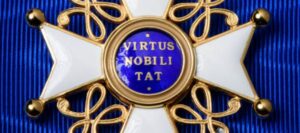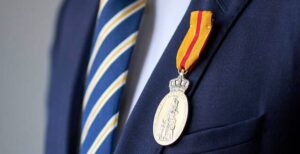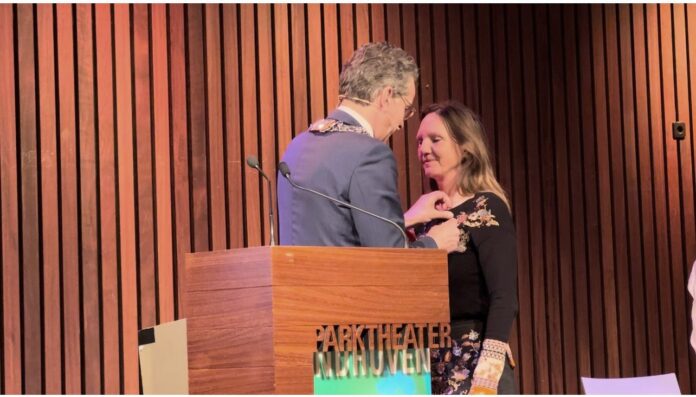Tomorrow is ‘Koningsdag‘, the birthday of His Majesty King Willem Alexander. On the last working day before his birthday, some 3,000 members of the public receive royal decorations. The decoration is a medal, worn on a ribbon, a ‘lintje’. That is why the event is popularly called the lintjesregen. And Eindhoven News is delighted to report that our founder, Irene Martens, received a ‘lintje’ today. She is now a Knight in the Order of Oranje-Nassau.
Thirteen years ago, Irene Martens, together with a few others, started Eindhoven News. Those were the days before the Expat Centre. After twenty years of living outside of the Netherlands, she effortlessly made friends with all nationalities because she thrives in an international atmosphere. A natural networker herself, she assumed leadership of the initiative when all the other founding members left. She worked tirelessly to take Eindhoven News from a blog to a recognised media outlet. Now, Eindhoven News is an ever-growing online News source for the internationals living in the region.

Community
In setting up and developing Eindhoven News, Irene’s efforts resulted in much more than an online news source for internationals. As part of international initiatives, including the Hub, connecting and collaboratiing, she has built not only an organisation but also a community. She has been instrumental in bringing internationals and locals together. Today’s Eindhoven needs such connectors who can foster inclusive growth. It is for this service to the community that she is decorated today.
Honours like the decoration in the Order of Oranje-Nassau that King Willem Alexander bestowed on Irene Martens today are conferred only in cases of outstanding service to the community.
Whose orders?
The history of orders in the Dutch honours system started with this man, King Willem I, King of The United Kingdom of the Netherlands and Grand Duke of Luxemburg. He declared himself King after the defeat of Napoleon in 1815.

The current Dutch king has chosen to be known as King Willem Alexander, instead of King Willem III. His ancestor King Willem I started the honours system when he needed to motivate soldiers and civilians to fight against Napoleon. The first person he decorated was his son, the Prince of Oranje, who would succeed him as Willem II. He received the Military order of Willem for his succes as commander-in-chief in the battle of Waterloo. As the monarch who confers this order now, King Willem Alexander has one too.

In the same year, Willem I established the Order of the Lion of the Netherlands. These days, people who receive this honour will have rendered exceptional service to the community, above and beyond what might have been expected of them, for example someone who has done pioneering scientific work of great value to society at large. The keyword is always ‘exceptional’, indicating an extraordinary achievement rooted in great talent.

Queen Emma, the wife of King William III, established a third order, The order of Oranje-Nassau, in 1892. The new Order recognised services to the Netherlands that were outstanding but not exceptional, in contrast to the Order of the Lion of the Netherlands.
Volunteers
Honours are conferred only in cases of outstanding service to the community. Most of those nominated for a royal decoration – generally people who have worked for many years as volunteers– are appointed Members of the Order of Oranje-Nassau. Irene received an even more prestigious medal, that of Knight in the Order of Oranje-Nassau.

Acts of great courage
These are the main decorations in the many-layered honours sytem. However, other well-deserved decorations also merit mentioning. One is The Medal for Acts of Humanity, founded in 1822. The brave man who rescued a soldier from a deep well prompted King Willem I to devise a medal for him. Over the years, it has been awarded to people who stood firm in dangerous situations at sea, during epidemics, calamities and other hazards. Those who perform acts of courage in dangerous situations, for example by overpowering robbers or attackers, can also receive the Medal.

Not for keeps
The actual decoration is only worn on the day it is conferred. A smaller version is worn on special occasions. A lapel badge can be worn every day. After the death of the recipient, the heirs must return the medal to the chancery, to prevent medals from turning up on E-Bay.
Do you know someone who should recieve an order? https://www.royalhonoursanddecorations.nl/nominations/nominations
Source: Chancery of the Dutch Orders
written and edited by: Greta and Beena
















